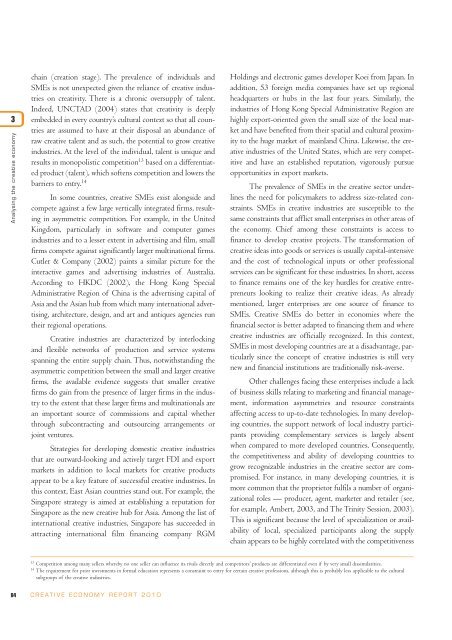Creative Economy: A Feasible Development Option
Creative Economy: A Feasible Development Option
Creative Economy: A Feasible Development Option
- No tags were found...
You also want an ePaper? Increase the reach of your titles
YUMPU automatically turns print PDFs into web optimized ePapers that Google loves.
3Analysing the creative economychain (creation stage). The prevalence of individuals andSMEs is not unexpected given the reliance of creative industrieson creativity. There is a chronic oversupply of talent.Indeed, UNCTAD (2004) states that creativity is deeplyembedded in every country’s cultural context so that all countriesare assumed to have at their disposal an abundance ofraw creative talent and as such, the potential to grow creativeindustries. At the level of the individual, talent is unique andresults in monopolistic competition 13 based on a differentiatedproduct (talent), which softens competition and lowers thebarriers to entry. 14In some countries, creative SMEs exist alongside andcompete against a few large vertically integrated firms, resultingin asymmetric competition. For example, in the UnitedKingdom, particularly in software and computer gamesindustries and to a lesser extent in advertising and film, smallfirms compete against significantly larger multinational firms.Cutler & Company (2002) paints a similar picture for theinteractive games and advertising industries of Australia.According to HKDC (2002), the Hong Kong SpecialAdministrative Region of China is the advertising capital ofAsia and the Asian hub from which many international advertising,architecture, design, and art and antiques agencies runtheir regional operations.<strong>Creative</strong> industries are characterized by interlockingand flexible networks of production and service systemsspanning the entire supply chain. Thus, notwithstanding theasymmetric competition between the small and larger creativefirms, the available evidence suggests that smaller creativefirms do gain from the presence of larger firms in the industryto the extent that these larger firms and multinationals arean important source of commissions and capital whetherthrough subcontracting and outsourcing arrangements orjoint ventures.Strategies for developing domestic creative industriesthat are outward-looking and actively target FDI and exportmarkets in addition to local markets for creative productsappear to be a key feature of successful creative industries. Inthis context, East Asian countries stand out. For example, theSingapore strategy is aimed at establishing a reputation forSingapore as the new creative hub for Asia. Among the list ofinternational creative industries, Singapore has succeeded inattracting international film financing company RGMHoldings and electronic games developer Koei from Japan. Inaddition, 53 foreign media companies have set up regionalheadquarters or hubs in the last four years. Similarly, theindustries of Hong Kong Special Administrative Region arehighly export-oriented given the small size of the local marketand have benefited from their spatial and cultural proximityto the huge market of mainland China. Likewise, the creativeindustries of the United States, which are very competitiveand have an established reputation, vigorously pursueopportunities in export markets.The prevalence of SMEs in the creative sector underlinesthe need for policymakers to address size-related constraints.SMEs in creative industries are susceptible to thesame constraints that afflict small enterprises in other areas ofthe economy. Chief among these constraints is access tofinance to develop creative projects. The transformation ofcreative ideas into goods or services is usually capital-intensiveand the cost of technological inputs or other professionalservices can be significant for these industries. In short, accessto finance remains one of the key hurdles for creative entrepreneurslooking to realize their creative ideas. As alreadymentioned, larger enterprises are one source of finance toSMEs. <strong>Creative</strong> SMEs do better in economies where thefinancial sector is better adapted to financing them and wherecreative industries are officially recognized. In this context,SMEs in most developing countries are at a disadvantage, particularlysince the concept of creative industries is still verynew and financial institutions are traditionally risk-averse.Other challenges facing these enterprises include a lackof business skills relating to marketing and financial management,information asymmetries and resource constraintsaffecting access to up-to-date technologies. In many developingcountries, the support network of local industry participantsproviding complementary services is largely absentwhen compared to more developed countries. Consequently,the competitiveness and ability of developing countries togrow recognizable industries in the creative sector are compromised.For instance, in many developing countries, it ismore common that the proprietor fulfils a number of organizationalroles — producer, agent, marketer and retailer (see,for example, Ambert, 2003, and The Trinity Session, 2003).This is significant because the level of specialization or availabilityof local, specialized participants along the supplychain appears to be highly correlated with the competitiveness13Competition among many sellers whereby no one seller can influence its rivals directly and competitors’ products are differentiated even if by very small dissimilarities.14The requirement for prior investments in formal education represents a constraint to entry for certain creative professions, although this is probably less applicable to the culturalsubgroups of the creative industries.84 CREATIVE ECONOMY REPORT 2010
















